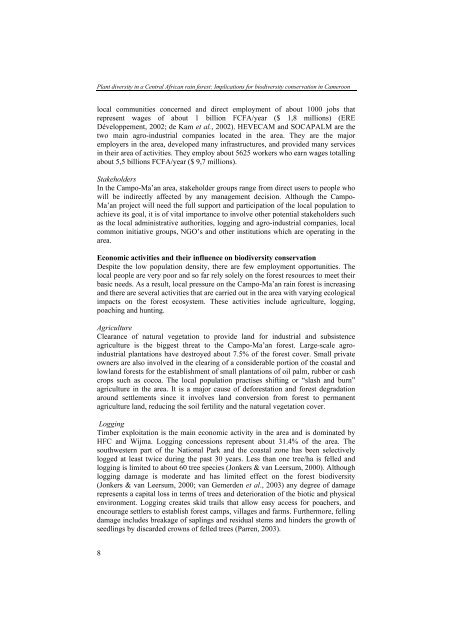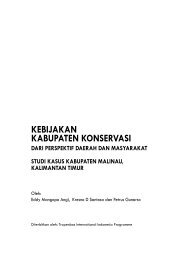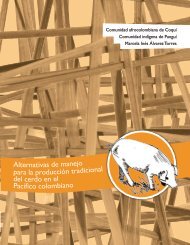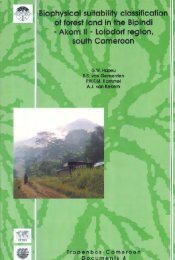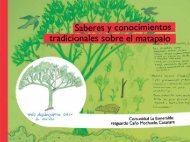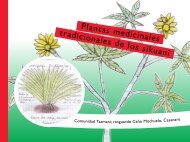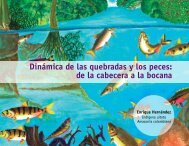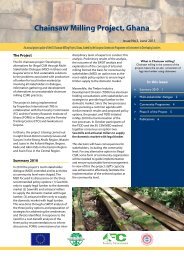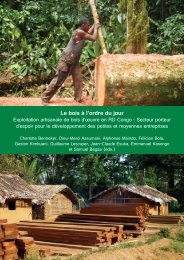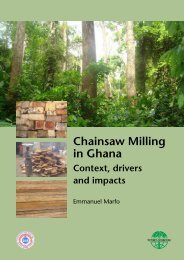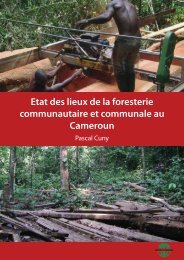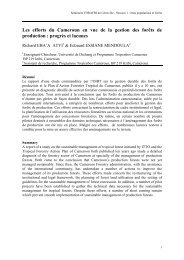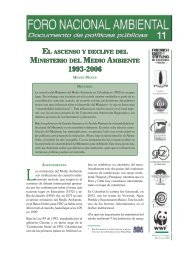Download the publication - Tropenbos International
Download the publication - Tropenbos International
Download the publication - Tropenbos International
You also want an ePaper? Increase the reach of your titles
YUMPU automatically turns print PDFs into web optimized ePapers that Google loves.
Plant diversity in a Central African rain forest: Implications for biodiversity conservation in Cameroon<br />
local communities concerned and direct employment of about 1000 jobs that<br />
represent wages of about 1 billion FCFA/year ($ 1,8 millions) (ERE<br />
Développement, 2002; de Kam et al., 2002). HEVECAM and SOCAPALM are <strong>the</strong><br />
two main agro-industrial companies located in <strong>the</strong> area. They are <strong>the</strong> major<br />
employers in <strong>the</strong> area, developed many infrastructures, and provided many services<br />
in <strong>the</strong>ir area of activities. They employ about 5625 workers who earn wages totalling<br />
about 5,5 billions FCFA/year ($ 9,7 millions).<br />
Stakeholders<br />
In <strong>the</strong> Campo-Ma’an area, stakeholder groups range from direct users to people who<br />
will be indirectly affected by any management decision. Although <strong>the</strong> Campo-<br />
Ma’an project will need <strong>the</strong> full support and participation of <strong>the</strong> local population to<br />
achieve its goal, it is of vital importance to involve o<strong>the</strong>r potential stakeholders such<br />
as <strong>the</strong> local administrative authorities, logging and agro-industrial companies, local<br />
common initiative groups, NGO’s and o<strong>the</strong>r institutions which are operating in <strong>the</strong><br />
area.<br />
Economic activities and <strong>the</strong>ir influence on biodiversity conservation<br />
Despite <strong>the</strong> low population density, <strong>the</strong>re are few employment opportunities. The<br />
local people are very poor and so far rely solely on <strong>the</strong> forest resources to meet <strong>the</strong>ir<br />
basic needs. As a result, local pressure on <strong>the</strong> Campo-Ma’an rain forest is increasing<br />
and <strong>the</strong>re are several activities that are carried out in <strong>the</strong> area with varying ecological<br />
impacts on <strong>the</strong> forest ecosystem. These activities include agriculture, logging,<br />
poaching and hunting.<br />
Agriculture<br />
Clearance of natural vegetation to provide land for industrial and subsistence<br />
agriculture is <strong>the</strong> biggest threat to <strong>the</strong> Campo-Ma’an forest. Large-scale agroindustrial<br />
plantations have destroyed about 7.5% of <strong>the</strong> forest cover. Small private<br />
owners are also involved in <strong>the</strong> clearing of a considerable portion of <strong>the</strong> coastal and<br />
lowland forests for <strong>the</strong> establishment of small plantations of oil palm, rubber or cash<br />
crops such as cocoa. The local population practises shifting or “slash and burn”<br />
agriculture in <strong>the</strong> area. It is a major cause of deforestation and forest degradation<br />
around settlements since it involves land conversion from forest to permanent<br />
agriculture land, reducing <strong>the</strong> soil fertility and <strong>the</strong> natural vegetation cover.<br />
Logging<br />
Timber exploitation is <strong>the</strong> main economic activity in <strong>the</strong> area and is dominated by<br />
HFC and Wijma. Logging concessions represent about 31.4% of <strong>the</strong> area. The<br />
southwestern part of <strong>the</strong> National Park and <strong>the</strong> coastal zone has been selectively<br />
logged at least twice during <strong>the</strong> past 30 years. Less than one tree/ha is felled and<br />
logging is limited to about 60 tree species (Jonkers & van Leersum, 2000). Although<br />
logging damage is moderate and has limited effect on <strong>the</strong> forest biodiversity<br />
(Jonkers & van Leersum, 2000; van Gemerden et al., 2003) any degree of damage<br />
represents a capital loss in terms of trees and deterioration of <strong>the</strong> biotic and physical<br />
environment. Logging creates skid trails that allow easy access for poachers, and<br />
encourage settlers to establish forest camps, villages and farms. Fur<strong>the</strong>rmore, felling<br />
damage includes breakage of saplings and residual stems and hinders <strong>the</strong> growth of<br />
seedlings by discarded crowns of felled trees (Parren, 2003).<br />
8


